English Essay: Comparing Adichie's and Anzaldúa's Perspectives
VerifiedAdded on 2023/06/04
|6
|1358
|423
Essay
AI Summary
This essay critically examines the dangers of forming opinions based on secondary sources, focusing on Chimamanda Adichie's 'The Danger of a Single Story' and Gloria Anzaldúa's 'How to Tame a Wild Tongue'. The essay explores Adichie's argument that single stories can be misleading, potentially distorting audience perceptions of cultures or places. It analyzes the impact of limited perspectives and the potential for false imaginations. The essay then connects Adichie's ideas to Anzaldúa's experiences with language and identity, particularly within the Chicano community. It highlights how language influences identity and how societal perceptions can be shaped by limited narratives, concluding that opinions should not be solely based on others' experiences. The essay draws upon the authors' arguments to emphasize the importance of diverse perspectives and the potential harm of relying on single stories.
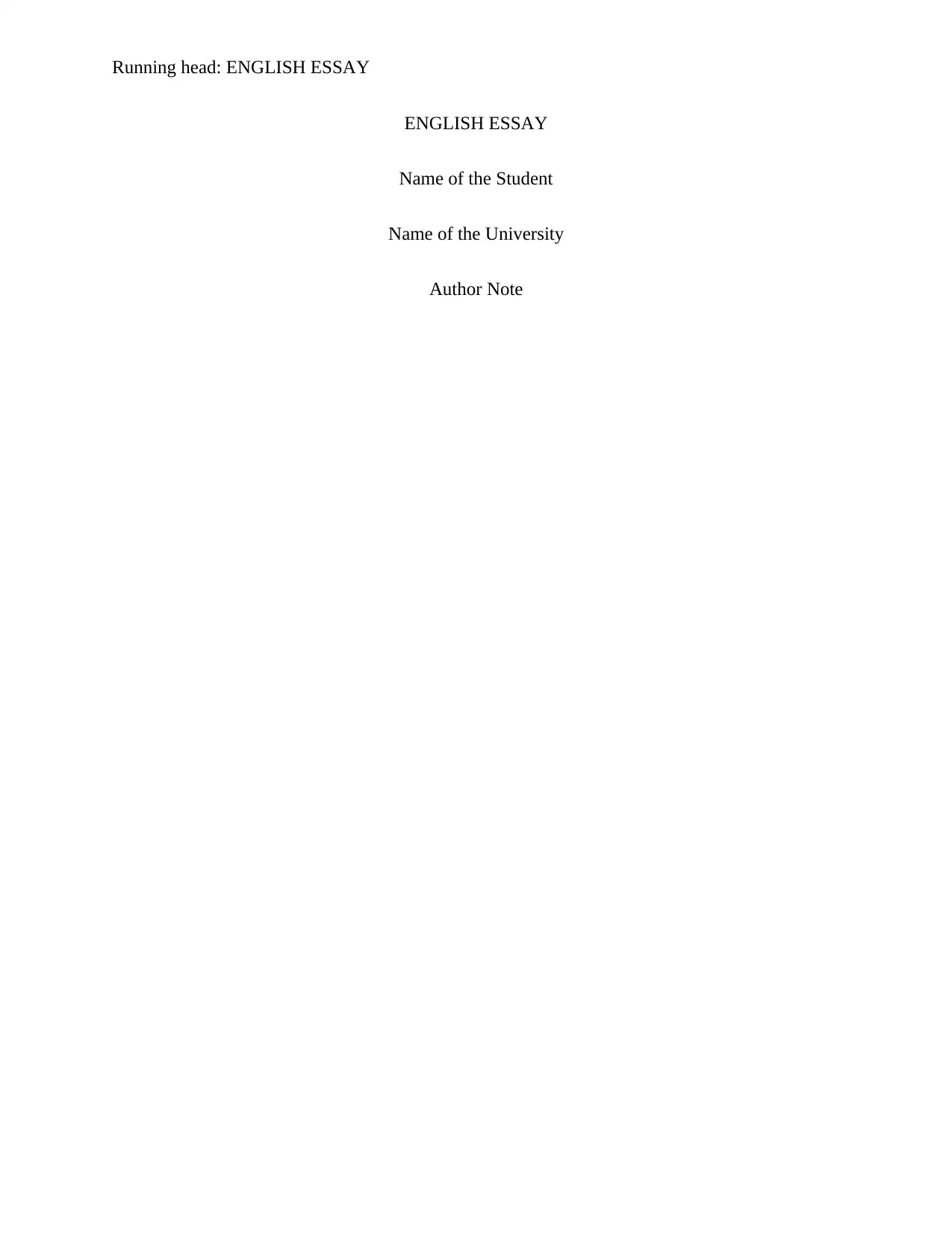
Running head: ENGLISH ESSAY
ENGLISH ESSAY
Name of the Student
Name of the University
Author Note
ENGLISH ESSAY
Name of the Student
Name of the University
Author Note
Paraphrase This Document
Need a fresh take? Get an instant paraphrase of this document with our AI Paraphraser
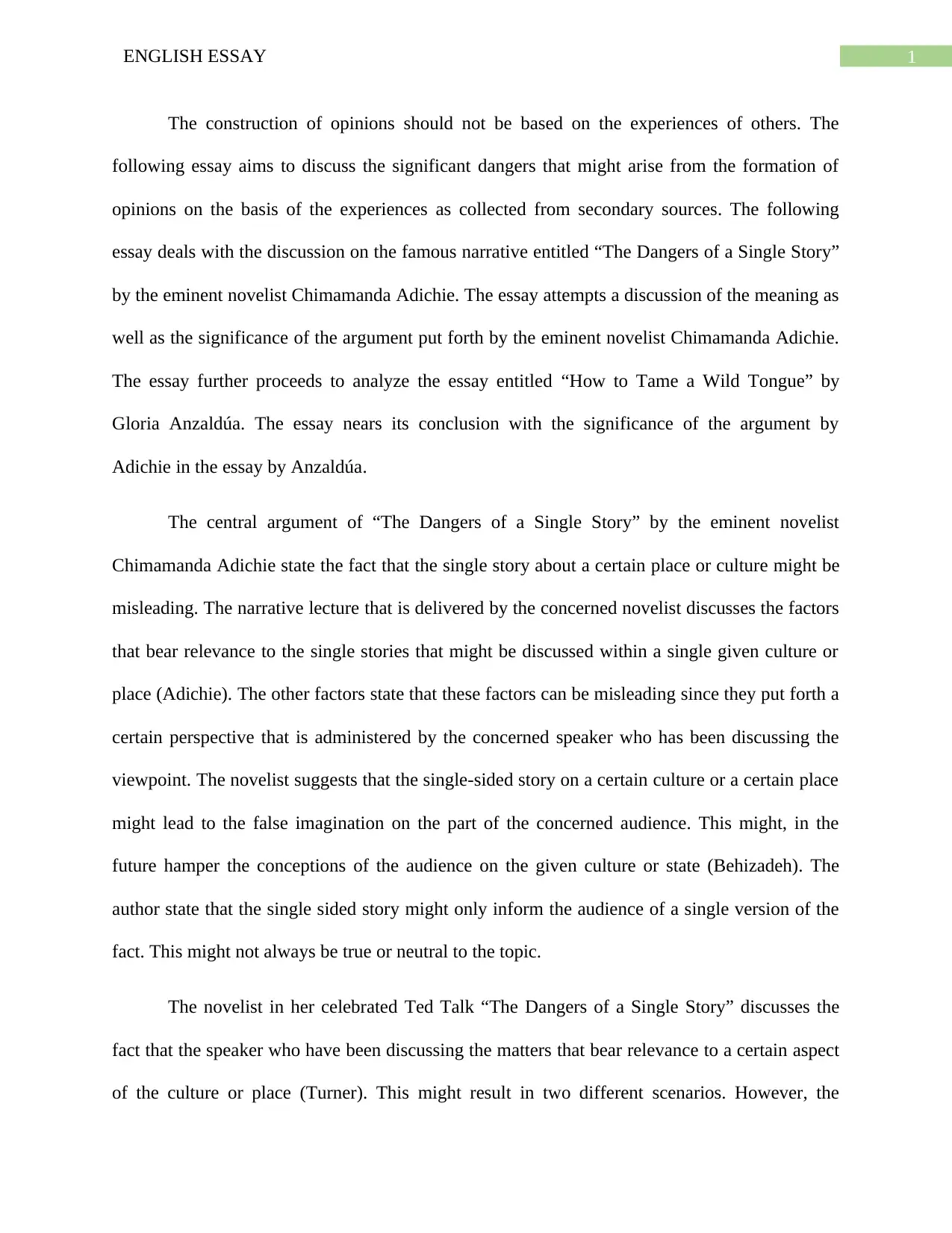
1ENGLISH ESSAY
The construction of opinions should not be based on the experiences of others. The
following essay aims to discuss the significant dangers that might arise from the formation of
opinions on the basis of the experiences as collected from secondary sources. The following
essay deals with the discussion on the famous narrative entitled “The Dangers of a Single Story”
by the eminent novelist Chimamanda Adichie. The essay attempts a discussion of the meaning as
well as the significance of the argument put forth by the eminent novelist Chimamanda Adichie.
The essay further proceeds to analyze the essay entitled “How to Tame a Wild Tongue” by
Gloria Anzaldúa. The essay nears its conclusion with the significance of the argument by
Adichie in the essay by Anzaldúa.
The central argument of “The Dangers of a Single Story” by the eminent novelist
Chimamanda Adichie state the fact that the single story about a certain place or culture might be
misleading. The narrative lecture that is delivered by the concerned novelist discusses the factors
that bear relevance to the single stories that might be discussed within a single given culture or
place (Adichie). The other factors state that these factors can be misleading since they put forth a
certain perspective that is administered by the concerned speaker who has been discussing the
viewpoint. The novelist suggests that the single-sided story on a certain culture or a certain place
might lead to the false imagination on the part of the concerned audience. This might, in the
future hamper the conceptions of the audience on the given culture or state (Behizadeh). The
author state that the single sided story might only inform the audience of a single version of the
fact. This might not always be true or neutral to the topic.
The novelist in her celebrated Ted Talk “The Dangers of a Single Story” discusses the
fact that the speaker who have been discussing the matters that bear relevance to a certain aspect
of the culture or place (Turner). This might result in two different scenarios. However, the
The construction of opinions should not be based on the experiences of others. The
following essay aims to discuss the significant dangers that might arise from the formation of
opinions on the basis of the experiences as collected from secondary sources. The following
essay deals with the discussion on the famous narrative entitled “The Dangers of a Single Story”
by the eminent novelist Chimamanda Adichie. The essay attempts a discussion of the meaning as
well as the significance of the argument put forth by the eminent novelist Chimamanda Adichie.
The essay further proceeds to analyze the essay entitled “How to Tame a Wild Tongue” by
Gloria Anzaldúa. The essay nears its conclusion with the significance of the argument by
Adichie in the essay by Anzaldúa.
The central argument of “The Dangers of a Single Story” by the eminent novelist
Chimamanda Adichie state the fact that the single story about a certain place or culture might be
misleading. The narrative lecture that is delivered by the concerned novelist discusses the factors
that bear relevance to the single stories that might be discussed within a single given culture or
place (Adichie). The other factors state that these factors can be misleading since they put forth a
certain perspective that is administered by the concerned speaker who has been discussing the
viewpoint. The novelist suggests that the single-sided story on a certain culture or a certain place
might lead to the false imagination on the part of the concerned audience. This might, in the
future hamper the conceptions of the audience on the given culture or state (Behizadeh). The
author state that the single sided story might only inform the audience of a single version of the
fact. This might not always be true or neutral to the topic.
The novelist in her celebrated Ted Talk “The Dangers of a Single Story” discusses the
fact that the speaker who have been discussing the matters that bear relevance to a certain aspect
of the culture or place (Turner). This might result in two different scenarios. However, the
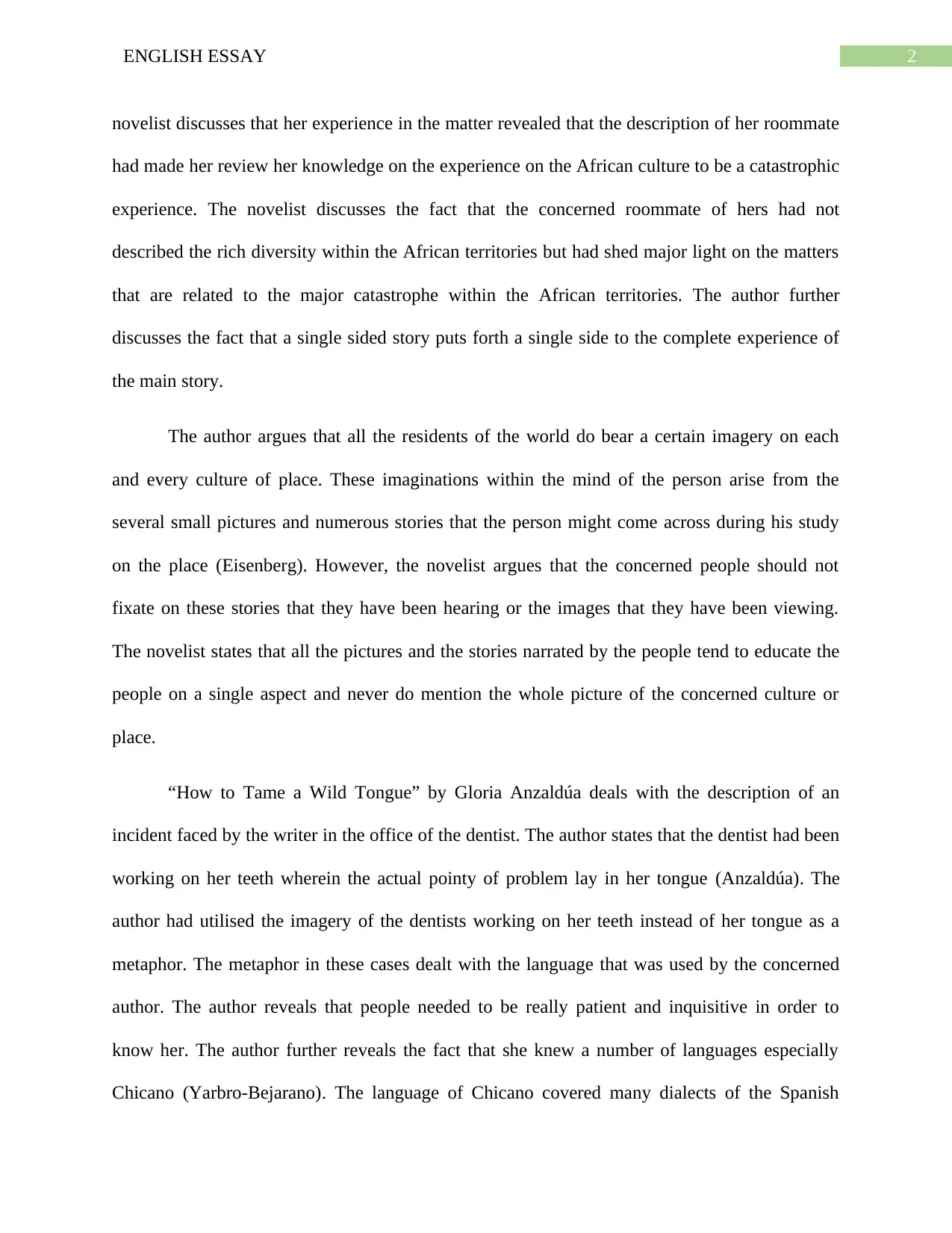
2ENGLISH ESSAY
novelist discusses that her experience in the matter revealed that the description of her roommate
had made her review her knowledge on the experience on the African culture to be a catastrophic
experience. The novelist discusses the fact that the concerned roommate of hers had not
described the rich diversity within the African territories but had shed major light on the matters
that are related to the major catastrophe within the African territories. The author further
discusses the fact that a single sided story puts forth a single side to the complete experience of
the main story.
The author argues that all the residents of the world do bear a certain imagery on each
and every culture of place. These imaginations within the mind of the person arise from the
several small pictures and numerous stories that the person might come across during his study
on the place (Eisenberg). However, the novelist argues that the concerned people should not
fixate on these stories that they have been hearing or the images that they have been viewing.
The novelist states that all the pictures and the stories narrated by the people tend to educate the
people on a single aspect and never do mention the whole picture of the concerned culture or
place.
“How to Tame a Wild Tongue” by Gloria Anzaldúa deals with the description of an
incident faced by the writer in the office of the dentist. The author states that the dentist had been
working on her teeth wherein the actual pointy of problem lay in her tongue (Anzaldúa). The
author had utilised the imagery of the dentists working on her teeth instead of her tongue as a
metaphor. The metaphor in these cases dealt with the language that was used by the concerned
author. The author reveals that people needed to be really patient and inquisitive in order to
know her. The author further reveals the fact that she knew a number of languages especially
Chicano (Yarbro-Bejarano). The language of Chicano covered many dialects of the Spanish
novelist discusses that her experience in the matter revealed that the description of her roommate
had made her review her knowledge on the experience on the African culture to be a catastrophic
experience. The novelist discusses the fact that the concerned roommate of hers had not
described the rich diversity within the African territories but had shed major light on the matters
that are related to the major catastrophe within the African territories. The author further
discusses the fact that a single sided story puts forth a single side to the complete experience of
the main story.
The author argues that all the residents of the world do bear a certain imagery on each
and every culture of place. These imaginations within the mind of the person arise from the
several small pictures and numerous stories that the person might come across during his study
on the place (Eisenberg). However, the novelist argues that the concerned people should not
fixate on these stories that they have been hearing or the images that they have been viewing.
The novelist states that all the pictures and the stories narrated by the people tend to educate the
people on a single aspect and never do mention the whole picture of the concerned culture or
place.
“How to Tame a Wild Tongue” by Gloria Anzaldúa deals with the description of an
incident faced by the writer in the office of the dentist. The author states that the dentist had been
working on her teeth wherein the actual pointy of problem lay in her tongue (Anzaldúa). The
author had utilised the imagery of the dentists working on her teeth instead of her tongue as a
metaphor. The metaphor in these cases dealt with the language that was used by the concerned
author. The author reveals that people needed to be really patient and inquisitive in order to
know her. The author further reveals the fact that she knew a number of languages especially
Chicano (Yarbro-Bejarano). The language of Chicano covered many dialects of the Spanish
⊘ This is a preview!⊘
Do you want full access?
Subscribe today to unlock all pages.

Trusted by 1+ million students worldwide
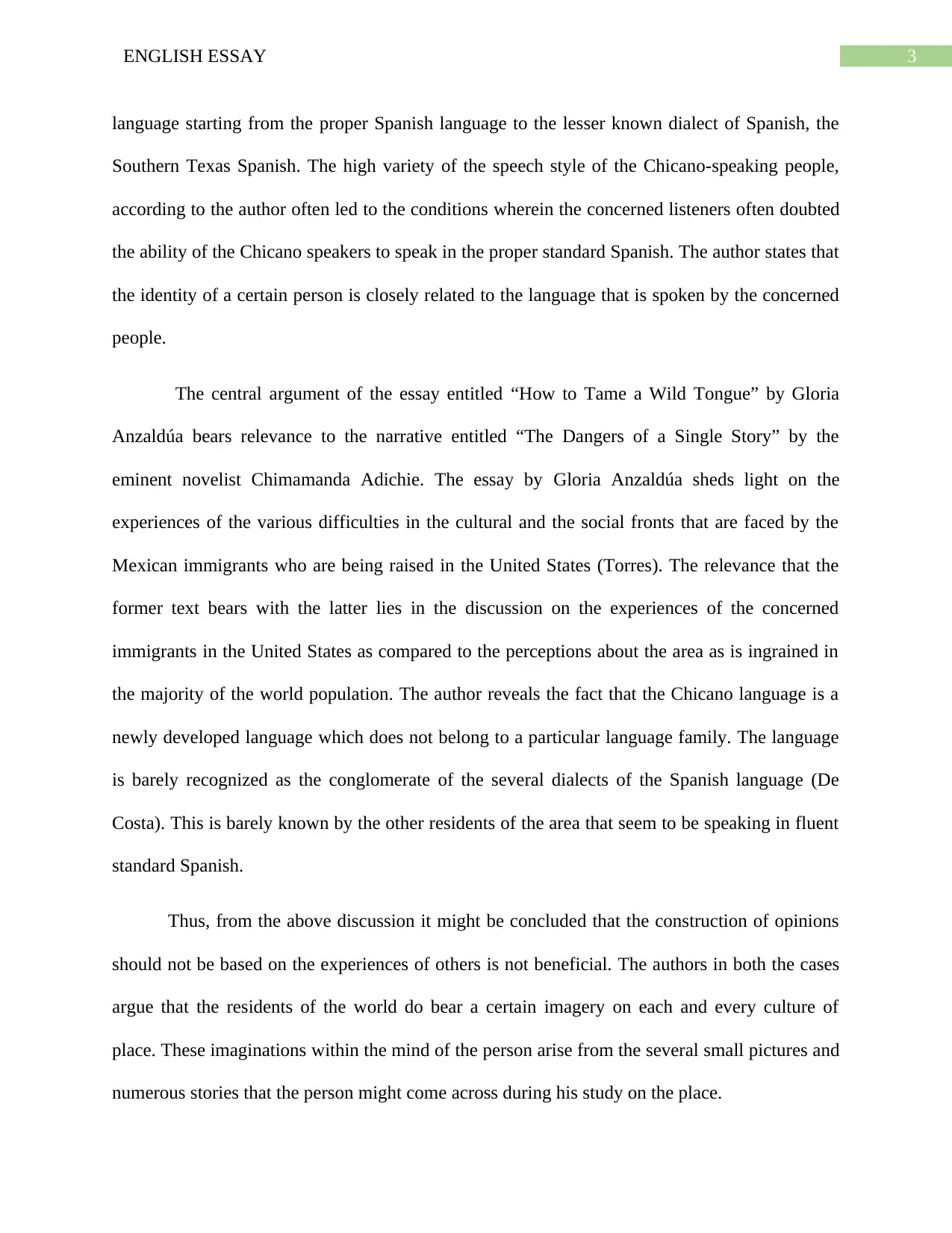
3ENGLISH ESSAY
language starting from the proper Spanish language to the lesser known dialect of Spanish, the
Southern Texas Spanish. The high variety of the speech style of the Chicano-speaking people,
according to the author often led to the conditions wherein the concerned listeners often doubted
the ability of the Chicano speakers to speak in the proper standard Spanish. The author states that
the identity of a certain person is closely related to the language that is spoken by the concerned
people.
The central argument of the essay entitled “How to Tame a Wild Tongue” by Gloria
Anzaldúa bears relevance to the narrative entitled “The Dangers of a Single Story” by the
eminent novelist Chimamanda Adichie. The essay by Gloria Anzaldúa sheds light on the
experiences of the various difficulties in the cultural and the social fronts that are faced by the
Mexican immigrants who are being raised in the United States (Torres). The relevance that the
former text bears with the latter lies in the discussion on the experiences of the concerned
immigrants in the United States as compared to the perceptions about the area as is ingrained in
the majority of the world population. The author reveals the fact that the Chicano language is a
newly developed language which does not belong to a particular language family. The language
is barely recognized as the conglomerate of the several dialects of the Spanish language (De
Costa). This is barely known by the other residents of the area that seem to be speaking in fluent
standard Spanish.
Thus, from the above discussion it might be concluded that the construction of opinions
should not be based on the experiences of others is not beneficial. The authors in both the cases
argue that the residents of the world do bear a certain imagery on each and every culture of
place. These imaginations within the mind of the person arise from the several small pictures and
numerous stories that the person might come across during his study on the place.
language starting from the proper Spanish language to the lesser known dialect of Spanish, the
Southern Texas Spanish. The high variety of the speech style of the Chicano-speaking people,
according to the author often led to the conditions wherein the concerned listeners often doubted
the ability of the Chicano speakers to speak in the proper standard Spanish. The author states that
the identity of a certain person is closely related to the language that is spoken by the concerned
people.
The central argument of the essay entitled “How to Tame a Wild Tongue” by Gloria
Anzaldúa bears relevance to the narrative entitled “The Dangers of a Single Story” by the
eminent novelist Chimamanda Adichie. The essay by Gloria Anzaldúa sheds light on the
experiences of the various difficulties in the cultural and the social fronts that are faced by the
Mexican immigrants who are being raised in the United States (Torres). The relevance that the
former text bears with the latter lies in the discussion on the experiences of the concerned
immigrants in the United States as compared to the perceptions about the area as is ingrained in
the majority of the world population. The author reveals the fact that the Chicano language is a
newly developed language which does not belong to a particular language family. The language
is barely recognized as the conglomerate of the several dialects of the Spanish language (De
Costa). This is barely known by the other residents of the area that seem to be speaking in fluent
standard Spanish.
Thus, from the above discussion it might be concluded that the construction of opinions
should not be based on the experiences of others is not beneficial. The authors in both the cases
argue that the residents of the world do bear a certain imagery on each and every culture of
place. These imaginations within the mind of the person arise from the several small pictures and
numerous stories that the person might come across during his study on the place.
Paraphrase This Document
Need a fresh take? Get an instant paraphrase of this document with our AI Paraphraser

4ENGLISH ESSAY
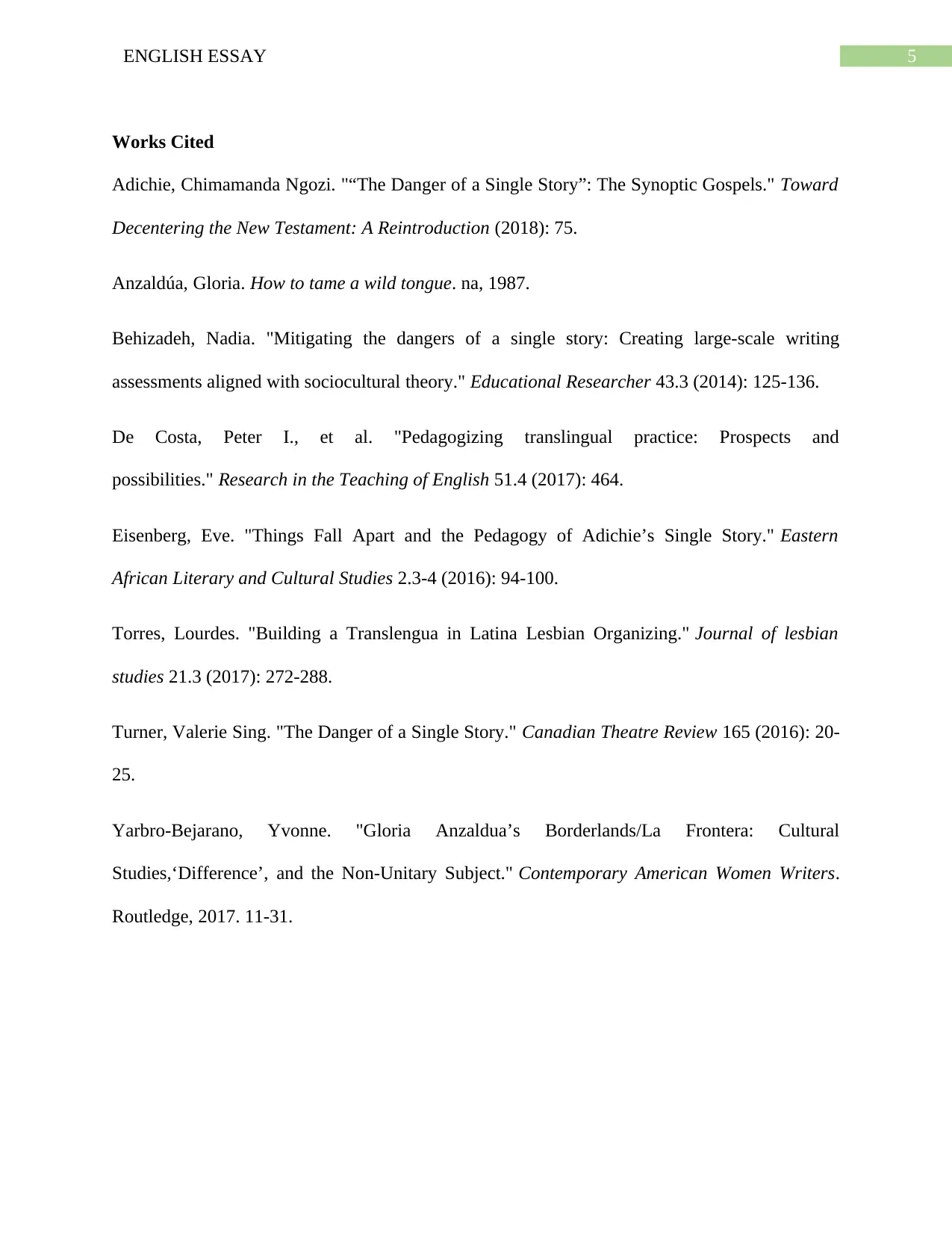
5ENGLISH ESSAY
Works Cited
Adichie, Chimamanda Ngozi. "“The Danger of a Single Story”: The Synoptic Gospels." Toward
Decentering the New Testament: A Reintroduction (2018): 75.
Anzaldúa, Gloria. How to tame a wild tongue. na, 1987.
Behizadeh, Nadia. "Mitigating the dangers of a single story: Creating large-scale writing
assessments aligned with sociocultural theory." Educational Researcher 43.3 (2014): 125-136.
De Costa, Peter I., et al. "Pedagogizing translingual practice: Prospects and
possibilities." Research in the Teaching of English 51.4 (2017): 464.
Eisenberg, Eve. "Things Fall Apart and the Pedagogy of Adichie’s Single Story." Eastern
African Literary and Cultural Studies 2.3-4 (2016): 94-100.
Torres, Lourdes. "Building a Translengua in Latina Lesbian Organizing." Journal of lesbian
studies 21.3 (2017): 272-288.
Turner, Valerie Sing. "The Danger of a Single Story." Canadian Theatre Review 165 (2016): 20-
25.
Yarbro-Bejarano, Yvonne. "Gloria Anzaldua’s Borderlands/La Frontera: Cultural
Studies,‘Difference’, and the Non-Unitary Subject." Contemporary American Women Writers.
Routledge, 2017. 11-31.
Works Cited
Adichie, Chimamanda Ngozi. "“The Danger of a Single Story”: The Synoptic Gospels." Toward
Decentering the New Testament: A Reintroduction (2018): 75.
Anzaldúa, Gloria. How to tame a wild tongue. na, 1987.
Behizadeh, Nadia. "Mitigating the dangers of a single story: Creating large-scale writing
assessments aligned with sociocultural theory." Educational Researcher 43.3 (2014): 125-136.
De Costa, Peter I., et al. "Pedagogizing translingual practice: Prospects and
possibilities." Research in the Teaching of English 51.4 (2017): 464.
Eisenberg, Eve. "Things Fall Apart and the Pedagogy of Adichie’s Single Story." Eastern
African Literary and Cultural Studies 2.3-4 (2016): 94-100.
Torres, Lourdes. "Building a Translengua in Latina Lesbian Organizing." Journal of lesbian
studies 21.3 (2017): 272-288.
Turner, Valerie Sing. "The Danger of a Single Story." Canadian Theatre Review 165 (2016): 20-
25.
Yarbro-Bejarano, Yvonne. "Gloria Anzaldua’s Borderlands/La Frontera: Cultural
Studies,‘Difference’, and the Non-Unitary Subject." Contemporary American Women Writers.
Routledge, 2017. 11-31.
⊘ This is a preview!⊘
Do you want full access?
Subscribe today to unlock all pages.

Trusted by 1+ million students worldwide
1 out of 6
Your All-in-One AI-Powered Toolkit for Academic Success.
+13062052269
info@desklib.com
Available 24*7 on WhatsApp / Email
![[object Object]](/_next/static/media/star-bottom.7253800d.svg)
Unlock your academic potential
Copyright © 2020–2025 A2Z Services. All Rights Reserved. Developed and managed by ZUCOL.
